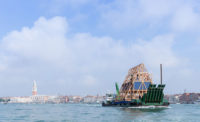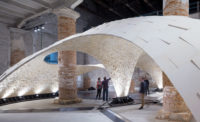Australia didn’t get the memo. Its contribution to the 15th Venice Architecture Biennale, which opens to the public Friday, is a celebration of swimming pools. The centerpiece — an actual pool inside the Denton Corker Marshall-designed pavilion — is a delight, but it has nothing to do with the Biennale theme, Reporting from the Front, established by curator Alejandro Aravena and meant to focus on ways architecture can help relieve the problems of the disadvantaged. True, public pools are a big part of Australian culture, but they’re not the kind of architectural humanitarianism Aravena had in mind.
The U.S. did get the memo, and answered it—with 12 speculative projects for four sites in Detroit that are crying out for innovation. The projects are smart, and much of the material filling the pavilion to the rafters, including a model by Mack Scogin Merrill Elam Architects, is visually compelling. (RECORD is a media sponsor of the U.S. Pavilion).
Kuwait definitely didn’t get the memo. Its catalogue was bound in silver, a false note at a biennale about the problems facing the 99 percent. Nor did Peter Zumthor, who filled his section of the Arsenale (the vast building in which much of the biennale takes place) with items related to his concept for the Los Angeles County Museum of Art. One was a room-sized, all-black model of a LACMA gallery, but it had so little detail that it did nothing to explain how Zumthor plans to turn his ideas into a building. There was also a display of Zumthor sketches, meant to show how his plans for the museum have evolved, and an installation (by the estimable fashion designer Christina Kim) demonstrating how the museum’s collection of textiles might be displayed. Zumthor apparently thinks Wilshire Boulevard is the “front.”
Luckily, the memo reached several other countries. Germany presents a survey of strategies for building and maintaining what the curators call the “arrival city”—a response to the 1 million immigrants who reached the country last year. The Netherlands, meanwhile, takes a fascinating look at the architecture of U.N. peacekeeping missions.
Britain’s exhibition puts forward ways housing can be made more affordable by breaking out of traditional construction and financing paradigms. One idea is for banks to finance bare-bones houses—with most appliances and fittings to be installed by the homeowner later—an interesting variant on Aravena’s own “incremental housing” strategy. But the plan is open to the same criticism some have leveled at Aravena’s half-finished houses in Chile—that putting the finishing touches on a building is cheaper for a large contractor than for individuals
Unsurprisingly, Aravena’s home country of Chile also organized a standout pavilion. Sheds, shelters, and agricultural pavilions—designed for the country’s central valley by architecture students—are presented in the form of handsome models beautifully presented on pedestals made out of metal roofing from houses that collapsed during the 2010 Chilean earthquake. The pavilion of the Western Sahara is a silvery, tent-like structure documenting the vernacular architecture and planning of the exiled Sahrawi people in Algeria. Poland’s pavilion also excels in form and content, using scaffolding to create a construction site-like environment in which visitors see videos about (and narrated by) men who earn a pittance building houses for the rich. In a video, a ditch digger recalled hearing a mother tell her toddler, “If you don't study you’ll end up like him.”
Poignant and, in the context of Aravena's biennale, perfectly on point!




















Post a comment to this article
Report Abusive Comment